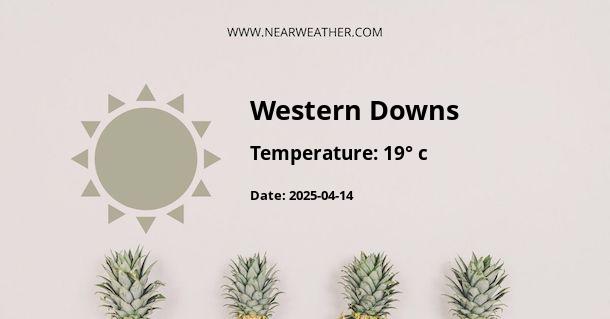Western Downs, Australia: A Detailed Look at its Climate and Weather Year Round
Located in Queensland, Australia, Western Downs is an area known for its rich natural resources, agricultural abundance, and diverse landscapes. Understanding the climate and weather patterns of Western Downs is crucial for residents, visitors, and businesses alike. This comprehensive guide provides an in-depth analysis of the region's climate, seasonal variations, and weather conditions throughout the year.
Climate Overview
Western Downs experiences a subtropical climate, characterized by hot summers and mild, dry winters. The region is known for its vast plains, agricultural lands, and unique biodiversity. The climate is influenced by its inland location, with limited maritime influence compared to coastal regions.
The climate of Western Downs can be classified as a hot semi-arid climate (BSh) according to the Köppen climate classification system. This classification indicates that the area experiences hot temperatures and low precipitation, particularly during the summer months.
Seasonal Variations
Understanding the seasonal variations in Western Downs is essential for planning activities, agriculture, and overall preparedness for weather changes.
Summer (December – February)
During the summer months, Western Downs experiences hot and dry conditions. The average maximum temperatures range from 32°C to 35°C, with occasional heatwaves leading to temperatures exceeding 40°C. Low humidity levels contribute to the arid nature of the region during this time.
The summer season is also characterized by sporadic thunderstorms, which can bring welcome relief from the heat but may also lead to localized flooding in some areas. It's important for residents and visitors to stay informed about weather warnings and preparedness measures during this period.
Autumn (March – May)
Autumn in Western Downs brings relief from the intense heat of summer. Average temperatures gradually decrease, ranging from 26°C to 29°C in March to 20°C to 23°C in May. The region experiences dry and clear days during this time, making it an ideal season for outdoor activities and agricultural pursuits.
Winter (June – August)
Winter in Western Downs is characterized by mild and dry conditions. Average maximum temperatures range from 18°C to 22°C, with cool nights often dropping to around 5°C to 8°C. The region experiences clear skies and minimal rainfall during this period, making it conducive for outdoor events and tourism activities.
Spring (September – November)
Spring heralds the transition to warmer temperatures in Western Downs. Average maximum temperatures range from 25°C to 29°C, with an increase in humidity levels compared to winter. Spring also marks the beginning of the storm season, with occasional thunderstorms and rainfall becoming more frequent as the season progresses.
Annual Weather Patterns and Precipitation
Western Downs experiences a distinct pattern of rainfall and weather events throughout the year. The region's agricultural activities are heavily influenced by the distribution of rainfall and the occurrence of extreme weather phenomena.
Rainfall Distribution
The annual rainfall in Western Downs is variable, with an average of 500mm to 600mm received per year. The majority of rainfall occurs during the summer months, often in the form of brief but intense thunderstorms. These summer rains are essential for sustaining agricultural activities and replenishing water sources in the region.
Conversely, the winter months are relatively dry, with minimal rainfall contributing to the arid conditions during this period. It's important for residents and businesses to implement water conservation measures and sustainable practices during these drier months.
Extreme Weather Events
Western Downs is susceptible to extreme weather events, including heatwaves, bushfires, and occasional flooding during the summer storm season. The region's emergency management and disaster preparedness efforts are critical in mitigating the impact of these events and ensuring the safety of the community.
Climatic Influences and Environmental Impact
The climate and weather patterns of Western Downs are influenced by various geographic and environmental factors. Understanding these influences is vital for adapting to the region's conditions and implementing sustainable practices.
Land Use and Agriculture
Western Downs is renowned for its agricultural productivity, with extensive cattle grazing, cotton farming, and grain cultivation contributing to the region's economic prosperity. The climate directly influences agricultural practices, water management, and crop yields, making it essential for farmers and landowners to adapt to the climatic variations.
Environmental Conservation
The unique biodiversity of Western Downs, including its native flora and fauna, is impacted by the region's climate and weather patterns. Conservation efforts, habitat restoration, and sustainable land management play a crucial role in preserving the natural environment and protecting vulnerable species in the face of climatic changes.
Conclusion
Western Downs, Australia, exhibits a distinct subtropical climate with seasonal variations that impact its residents, businesses, and natural landscapes. By understanding the climate and weather patterns of Western Downs, individuals and organizations can make informed decisions, implement sustainable practices, and prepare for the challenges and opportunities presented by the region's climatic conditions.
For more information on Western Downs' climate and weather, please refer to the Australian Bureau of Meteorology and local government resources for comprehensive and up-to-date data.
A - Western Downs's Latitude is -26.806650 & Longitude is 150.385895.
A - Weather in Western Downs is 19° today.
A - Climate Conditions in Western Downs shows clear sky today.
A - Humidity in Western Downs is 68% today.
A - Wind speed in Western Downs is 28.55 km/h, flowing at 99° wind direction. today.
